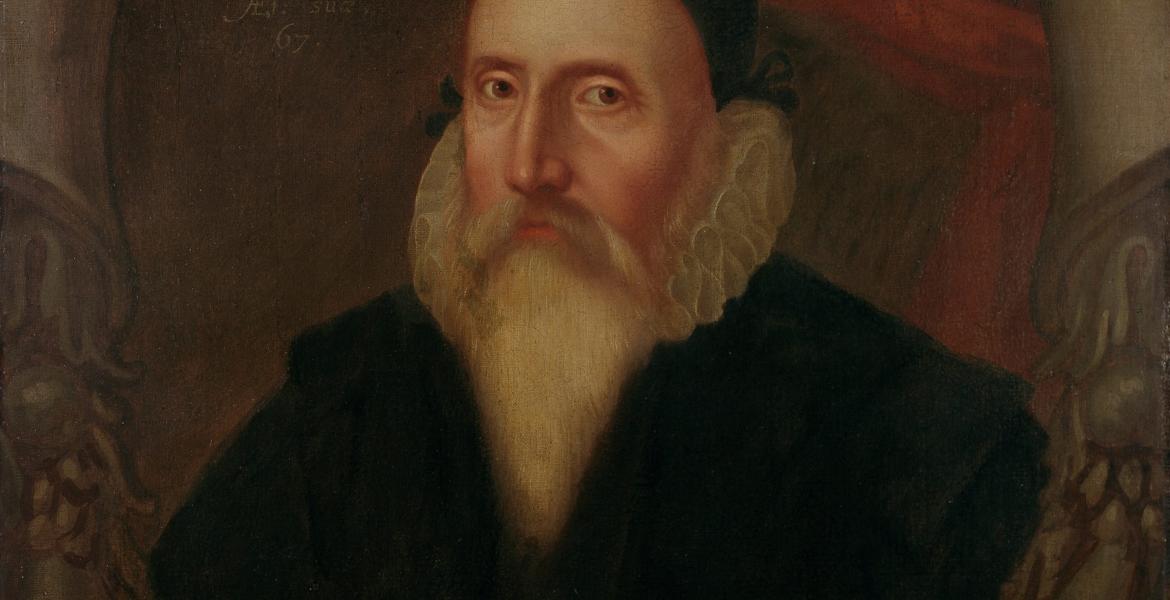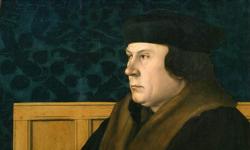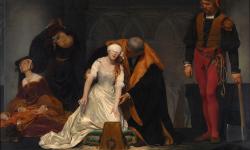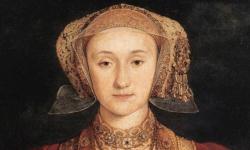Ten Facts You Might Not Know about John Dee
John Dee is famous as a sorcerer and alchemistSomeone who practices alchemy (the attempt to turn base metals into gold and to gain spiritual awareness and immortality).Someone who practices alchemy (the attempt to turn base metals into gold and to gain spiritual awareness and immortality). Someone who practices alchemy (the attempt to turn base metals into gold and to gain spiritual awareness and immortality). Someone who practices alchemy (the attempt to turn base metals into gold and to gain spiritual awareness and immortality). Someone who practices alchemy (the attempt to turn base metals into gold and to gain spiritual awareness and immortality). Someone who practices alchemy (the attempt to turn base metals into gold and to gain spiritual awareness and immortality). Someone who practices alchemy (the attempt to turn base metals into gold and to gain spiritual awareness and immortality). , a quack doctorAn unqualified person who claims medical knowledge or other skills.An unqualified person who claims medical knowledge or other skills. An unqualified person who claims medical knowledge or other skills. An unqualified person who claims medical knowledge or other skills. An unqualified person who claims medical knowledge or other skills. An unqualified person who claims medical knowledge or other skills. An unqualified person who claims medical knowledge or other skills. and astrologer for Queen Elizabeth. Since even before his death, but particularly during the ‘scientific revolution’, his reputation has taken a beating for his absolute belief in the supernatural and for his superstitious practices – trying to find the philosophers’ stone, conversing with angels, and casting nativitiesTo find out and represent the position of the heavenly bodies at the time of people's births in order to make astrological predictions.To find out and represent the position of the heavenly bodies at the time of people's births in order to make astrological predictions. To find out and represent the position of the heavenly bodies at the time of people's births in order to make astrological predictions. To find out and represent the position of the heavenly bodies at the time of people's births in order to make astrological predictions. To find out and represent the position of the heavenly bodies at the time of people's births in order to make astrological predictions. To find out and represent the position of the heavenly bodies at the time of people's births in order to make astrological predictions. To find out and represent the position of the heavenly bodies at the time of people's births in order to make astrological predictions. . But in reality, he was a great polymathA person of wide knowledge or learning.A person of wide knowledge or learning.A person of wide knowledge or learning.A person of wide knowledge or learning.A person of wide knowledge or learning.A person of wide knowledge or learning.A person of wide knowledge or learning., well-learned and travelled, and respected by many in England and beyond. His life can tell us much about that crossover between the medieval and ‘modern’ ways of thinking and living, and as such deserves to be studied more.
He was the ultimate Renaissance manA person with many talents or areas of knowledge.A person with many talents or areas of knowledge. A person with many talents or areas of knowledge. A person with many talents or areas of knowledge. A person with many talents or areas of knowledge. A person with many talents or areas of knowledge. A person with many talents or areas of knowledge.
John Dee didn’t just study astrology and alchemy, but was an expert in the ancient languages, law, and modern ‘scientific’ disciplines such as mathematics and navigation. He was even good with mechanics: the stage machinery he devised for a performance of Aristophanes' Pax first gave him a reputation as a conjuror. After studying at St John’s College, Cambridge – where he boasted that he studied for up to 18 hours per day – he became one of the first fellows of the newly established Trinity College in 1546. He lectured on Euclid in Rheims and is said to have rejected a professorship of mathematics at Paris, despite the attractive salary offered of 200 crowns (very roughly, about £200,000 today), and later declined to read the mathematical sciences at Oxford. It is also possible that he earned a doctorate in medicine from the University of Prague, at some point in 1585-6 (hence the title ‘Dr’).
His library was the envy of universities
Dee spent decades searching the country and Europe to build up his library, claiming at one point to have owned over 3,000 books and 1,000 manuscriptsBooks, documents, or piece of musics written by hand rather than typed or printed. Later, pieces of work that have not yet been published.Books, documents, or piece of musics written by hand rather than typed or printed. Later, pieces of work that have not yet been published. Books, documents, or piece of musics written by hand rather than typed or printed. Later, pieces of work that have not yet been published. Books, documents, or piece of musics written by hand rather than typed or printed. Later, pieces of work that have not yet been published. Books, documents, or piece of musics written by hand rather than typed or printed. Later, pieces of work that have not yet been published. Books, documents, or piece of musics written by hand rather than typed or printed. Later, pieces of work that have not yet been published. Books, documents, or piece of musics written by hand rather than typed or printed. Later, pieces of work that have not yet been published. – one of the best collections in England and considerably better than those of Oxford and Cambridge universities – all of which were kept at his home at Mortlake, Surrey. He even took a significant library with him when he travelled: when he left for Poland in 1583, he took 800 books with him. It is lucky that he did, for when he returned six years later his house, and library, many of his books, and much of his equipment, had been stolen. He had left his house in the care of his brother-in-law, Nicholas Fromoundes, to whom he owed £400. It is therefore likely that Fromoundes allowed access to the house as a means of recuperating his losses. Many of the culprits were former associates and students of Dee and he did manage to recover some of his beloved books. But not all: his library remains dispersed and books that he once owned are scattered around the country, in collections belonging to the British Library, Corpus Christi College, Oxford, and the Royal College of Physicians.
Gerardus Mercator was a chum
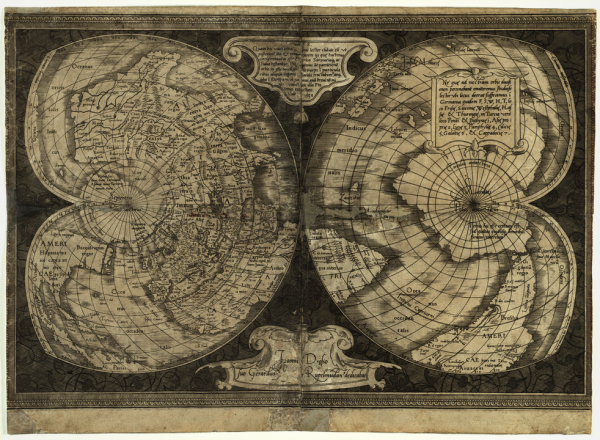
When in Louvain (in modern Belgium) in 1547 John Dee quickly formed a close friendship with the great cartographerA person who draws or produces maps.A person who draws or produces maps. A person who draws or produces maps. A person who draws or produces maps. A person who draws or produces maps. A person who draws or produces maps. A person who draws or produces maps. Gerardus Mercator. As with Dee, Mercator loved books and was a polymath, interested in history, theology, philosophy and astronomy as well as the geography for which he is known today. The following year Dee enrolled at Mercator’s university in Louvain – although he didn’t graduate – and the pair continued to build their relationship. When Dee eventually returned to England, he brought several of Mercator’s maps, globes and other instruments with him, which he used to help advise on the hunt for the north-west passageA hypothetical sea route across the north of the American continent to connect the Atlantic with the Pacific oceans.A hypothetical sea route across the north of the American continent to connect the Atlantic with the Pacific oceans. A hypothetical sea route across the north of the American continent to connect the Atlantic with the Pacific oceans. A hypothetical sea route across the north of the American continent to connect the Atlantic with the Pacific oceans. A hypothetical sea route across the north of the American continent to connect the Atlantic with the Pacific oceans. A hypothetical sea route across the north of the American continent to connect the Atlantic with the Pacific oceans. A hypothetical sea route across the north of the American continent to connect the Atlantic with the Pacific oceans. and other voyages. As such, Dee was important in spreading Mercator’s work – and a better understanding of navigation – in England.
A different hunt for gold
Dee was a keen advocate of the ‘British Empire’, and was, in fact, the first person recorded as using that term. General and Rare Memorials, R. Julian Roberts, ‘Dee, John’ at ODNB. He forwarded the idea that Elizabeth had a natural right to northern and western realms, based on ‘historical’ notions of King Arthur and the mythical Welsh prince, Madog ab Owain Gwynedd, and pushed the economic, political, and religious reasons for expansion into America. He was also involved in the practical side, using his navigational knowledge – and his cash – to help plan the voyages of Martin Frobisher to the New World, the exploits of the Muscovy Company in finding a north-eastern passage to the Far East, and what would later become Sir Walter Ralegh’s attempt to discover a north-west passage to the Pacific.
General and Rare Memorials, R. Julian Roberts, ‘Dee, John’ at ODNB. He forwarded the idea that Elizabeth had a natural right to northern and western realms, based on ‘historical’ notions of King Arthur and the mythical Welsh prince, Madog ab Owain Gwynedd, and pushed the economic, political, and religious reasons for expansion into America. He was also involved in the practical side, using his navigational knowledge – and his cash – to help plan the voyages of Martin Frobisher to the New World, the exploits of the Muscovy Company in finding a north-eastern passage to the Far East, and what would later become Sir Walter Ralegh’s attempt to discover a north-west passage to the Pacific.
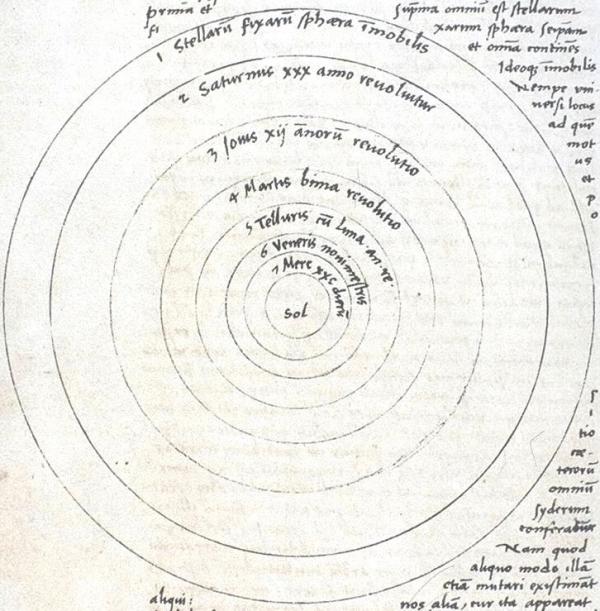
He was an early adopter of Copernican theories of heliocentrismA model of the solar system/universe in which the Sun is assumed to lie at the centre, with the planets orbiting it.A model of the solar system/universe in which the Sun is assumed to lie at the centre, with the planets orbiting it. A model of the solar system/universe in which the Sun is assumed to lie at the centre, with the planets orbiting it. A model of the solar system/universe in which the Sun is assumed to lie at the centre, with the planets orbiting it. A model of the solar system/universe in which the Sun is assumed to lie at the centre, with the planets orbiting it. A model of the solar system/universe in which the Sun is assumed to lie at the centre, with the planets orbiting it. A model of the solar system/universe in which the Sun is assumed to lie at the centre, with the planets orbiting it.
Unlike many English mathematicians of his time, Dee was an early supporter of Nicolaus Copernicus who, in De revolutionibus orbium coelestium suggested a helio- rather than geocentricA model of the universe in which the earth lies at the centre.A model of the universe in which the earth lies at the centre. A model of the universe in which the earth lies at the centre. A model of the universe in which the earth lies at the centre. A model of the universe in which the earth lies at the centre. A model of the universe in which the earth lies at the centre. A model of the universe in which the earth lies at the centre. view of the universe. Despite heliocentric ideas existing in Europe and beyond for over a thousand years, the theory was not initially popular in Europe as it contradicted both the early modern understanding of the Bible and the works of the great classical philosophers. Yet Dee saw the practical benefits of the model, not least how it explained the retrogradeMoving backwardsMoving backwards Moving backwards Moving backwards Moving backwards Moving backwards Moving backwards motion of the planets important to astrology and astronomy, and waxed lyrical about it in publications (he also had two copies of the book in his library).
He almost caused England to lose 11 days – 169 years early!
Thanks to the problems with the Julian calendar, which had been proposed by Julius Caesar in 46 BCE'Before common era', the non-religious way of saying 'BC' (which means 'before Christ').'Before common era', the non-religious way of saying 'BC' (which means 'before Christ').'Before common era', the non-religious way of saying 'BC' (which means 'before Christ').'Before common era', the non-religious way of saying 'BC' (which means 'before Christ').'Before common era', the non-religious way of saying 'BC' (which means 'before Christ').'Before common era', the non-religious way of saying 'BC' (which means 'before Christ').'Before common era', the non-religious way of saying 'BC' (which means 'before Christ'). (and took effect in 45 BCE), Christian holy days had been falling more and more out of line with the cycles of the sun and the seasons. Pope Gregory XIII thus introduced a new calendar in 1582, which caught up with the solar calendar and was implemented across much of Catholic Europe shortly thereafter. The Gregorian calendar doesn’t quite line up with the solar year either: it is 26 seconds out per year. Although it took England almost 200 years to implement it, the calendar had been considered at almost the moment of its inception: Dee was tasked to look into it by the Elizabethan government, and reported back in February 1583. He agreed that the Gregorian calendar was much superior, but suggested jumping forwards by 11 rather than the suggested 10 days (which is what happened when Britain adopted the calendar in 1752). Sadly, the bishops and other religious leaders opposed the idea because it was too Catholic.
The Gregorian calendar doesn’t quite line up with the solar year either: it is 26 seconds out per year. Although it took England almost 200 years to implement it, the calendar had been considered at almost the moment of its inception: Dee was tasked to look into it by the Elizabethan government, and reported back in February 1583. He agreed that the Gregorian calendar was much superior, but suggested jumping forwards by 11 rather than the suggested 10 days (which is what happened when Britain adopted the calendar in 1752). Sadly, the bishops and other religious leaders opposed the idea because it was too Catholic.
John Foxe recorded him as a martyr-maker
Despite in later life associating with the more godly of Elizabeth’s court, Dee had no protestantSomeone following the western non-Catholic Christian belief systems inspired by the Protestant Reformation.Someone following the western non-Catholic Christian belief systems inspired by the Protestant Reformation.Someone following the western non-Catholic Christian belief systems inspired by the ProtestantSomeone following the western non-Catholic Christian belief systems inspired by the Protestant Reformation. Reformation.Someone following the western non-Catholic Christian belief systems inspired by the ProtestantSomeone following the western non-Catholic Christian belief systems inspired by the Protestant Reformation. Reformation.Someone following the western non-Catholic Christian belief systems inspired by the ProtestantSomeone following the western non-Catholic Christian belief systems inspired by the Protestant Reformation. Reformation.Someone following the western non-Catholic Christian belief systems inspired by the ProtestantSomeone following the western non-Catholic Christian belief systems inspired by the Protestant Reformation. Reformation.Someone following the western non-Catholic Christian belief systems inspired by the ProtestantSomeone following the western non-Catholic Christian belief systems inspired by the Protestant Reformation. Reformation. zeal. In 1555 Dee was arrested with a number of other academics and people near to the Lady Elizabeth, initially accused of calculating Queen Mary’s nativity, and later of witchcraft and sorcery. However, he was friends with Edward Bonner, bishop of London, so the charges came to nothing. By 1556 he was Bonner's chaplain, with his skills being used in heresyA belief or opinion that goes against the official Church doctrine.A belief or opinion that goes against the official Church doctrineThe set of beliefs upheld by a religion or political party..A belief or opinion that goes against the official Church doctrineThe set of beliefs upheld by a religion or political party. .A belief or opinion that goes against the official Church doctrineThe set of beliefs upheld by a religion or political party. . investigations. As a result, in earlier versions of John Foxe’s Acts and Monuments – or the Book of Martyrs – his name and his links to the Dark Arts are mentioned during the examination of the martyr John Philpot on 19 November 1556. In later versions of Foxe's book, however, Dee’s name is missing: Elizabeth I and her court didn't want to be seen to be taking advice from a Catholic conjurer.
Mirror, mirror…
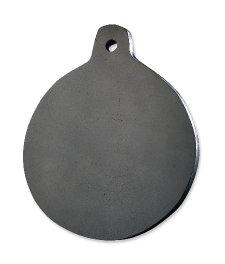
Dee owned a ‘spirit mirror’, a reflective piece of the volcanic glass obsidian, which had originated in Mexico and come to Europe following Hernando CortésA Spanish conquistador who led an expedition that caused the fall of the Aztec Empire and brought large portions of its land under the rule of the king of Castile.’s conquest in 1527-30. He had intended to use it for communicating with benevolent spirits – including attempting to find out information about the north-west passage – and to summon angels, as well as to learn the secrets of alchemy, but despite his interest, Dee couldn’t get the knack of using it. He thus enlisted a series of unsavoury types to act as mediums – as well as attempting to train his son in its use – who included the fraudulent Barnabas Saul and the notorious criminal Edward Kelley. The mirror is now on display in the British Museum.
His wife got pregnant during an ‘angel-sanctioned’ wife swap.
It was while working with Edward Kelley that a spirit called Madimi instructed Dee and Kelley to hold all things in common. After much soul-searching – on the part of Dee and his wife anyway – an agreement was drawn up and the couples swapped. In 1588, almost exactly forty weeks to the day afterwards, Dee’s wife Jane gave birth to a son, Theodore. Although Dee didn’t specifically refer to the conception in any of the writings that have come down to us, the name ‘Theodore’, which means ‘gift of God’, gives some clue as to his thoughts. Another child, born in 1590, was named Madimi.
Another child, born in 1590, was named Madimi.
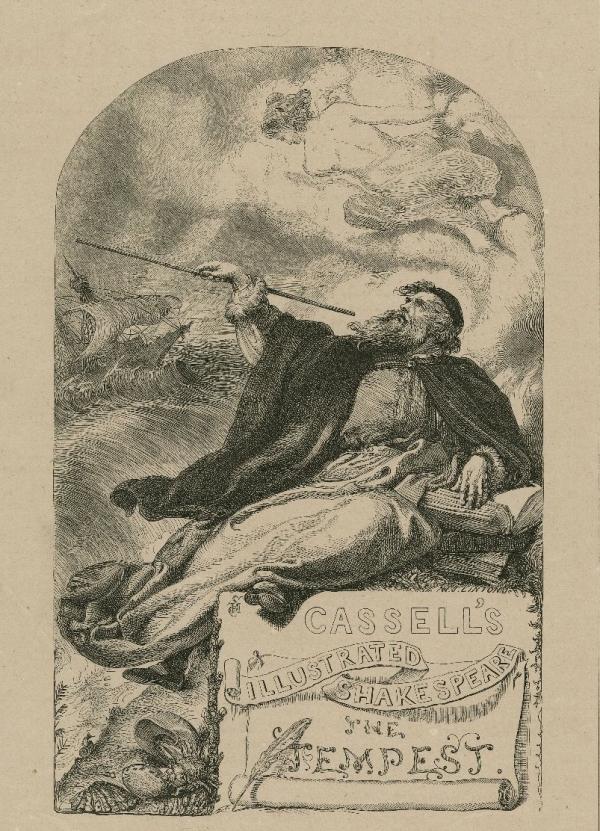
John Dee is often considered as the inspiration for Prospero, Shakespeare’s magician in The Tempest
In the play, Prospero is the rightful duke of Milan, who was exiled by his brother and who found sanctuary on a small island. A lover of books, through them he finds both knowledge and power, specifically the power to contact spirits and to perform magic. Dee, who was contemporarySomeone or something living or occurring at the same time.Someone or something living or occurring at the same time.Someone or something living or occurring at the same time.Someone or something living or occurring at the same time.Someone or something living or occurring at the same time.Someone or something living or occurring at the same time.Someone or something living or occurring at the same time. with Shakespeare, shares many of the same traits: at one point he was involved with politics and the court of Elizabeth I, he had an extensive library, which he used to obtain both natural and supernatural knowledge, and he tried to put that supernatural knowledge into effect. He also suffered something of a downfall: by the turn of the century, he was no longer rich and had to rely on begging letters, odd-job teaching, and his salary from his wardenship of the collegiate church in Manchester. But, unlike Prospero, Dee’s life didn’t end with such a sense of hope. In 1605 Dee’s wife, Jane, and several of their children died of plague. John Dee followed in 1608 or 1609, dying in poverty and obscurity. It’s a sad end for such a fascinating and undervalued man.
- Log in to post comments


